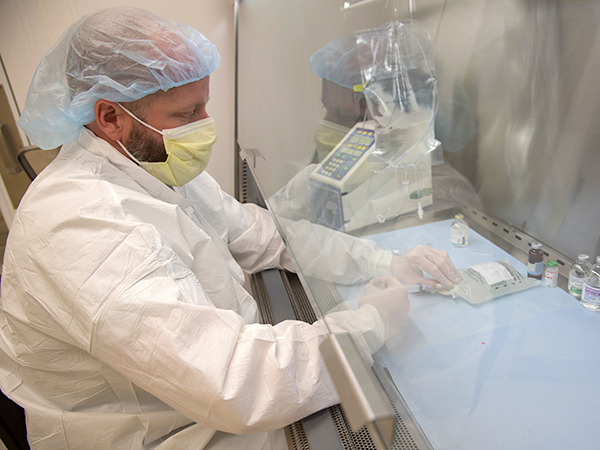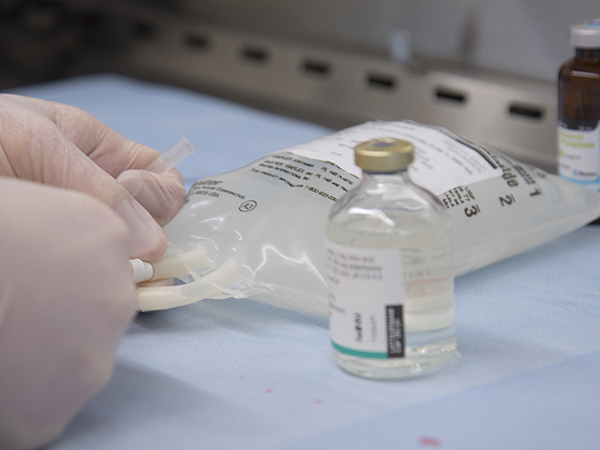Value Analysis promotes culture of savings, efficiency

Why should caregivers in pediatrics use adult-sized wipes on tots and babies when baby wipes are all that's needed?
Why eat a non-reimbursable $272 to wake up a Medical ICU patient at 3 a.m. for “routine” lab work that always includes a chest X-ray, when the tests aren't necessary in the first place
Why use two sponges for a gastrointestinal procedure when one will do? And, why use a particular disposable lab coat when you can get the same quality from a different vendor for almost half the price?
Front-line staff at the University of Mississippi Medical Center are asking themselves those questions - and coming up with solutions. Since inception of the Value Analysis program in 2015, UMMC has been able to capture more than $19 million in savings. In FY16 alone, the dollar figure was almost $9 million. Among those gleanings: $25,000 annually on the wipes, with the potential for another $60,000 a year; $25,000 annually on the lab coats; and $8,000 on the sponges.
Other initiatives, including product standardizations, taking advantage of Group Purchasing Organization pricing and contract negotiations make up the total annualized savings.
The goal: Save UMMC money by eliminating waste, redundancy and inefficiency, and putting into motion cost-saving vehicles.
The Medical Center embarked on the Value Analysis program to identify operational cost-saving opportunities. Eight teams have been formed, representing DIS, UMMC Grenada and Holmes County, laboratory services, patient care, pharmacy, perioperative, procedural and support services. Each set savings goals and developed initiatives to identify and implement internal savings opportunities, much of it in procurement of commodities and services.
The breakdown of savings since the program began is an eye-opener: $1.26 million, DIS; $584,543, UMMC Grenada and Holmes County; $2.78 million, Laboratory Services; $1.54 million, Patient Care; $3.93 million, Perioperative; $3.42 million, Pharmacy; $3.3 million, Procedural; and $2.2 million, Support Services.
“Drug prices are escalating at a very high pace, and there's a lot of opportunity there,” said Todd Dear, director of pharmacy and chair of the Pharmacy Value Analysis Team. “We saved money by traditional contract negotiation.”
But often, he said, savings are realized when a front-line staffer sees a better way of doing things. One example is changing administration of the drug Emend, which is given to lessen the side effects of chemotherapy, to IV rather than by mouth.

Harrison prepares an IV bag.
“We saved $25,000 a year by them noticing that IV is cheaper, and works just as well,” Dear said of pharmacists James Madaris and Justin Harrison. “You have to think out of the box on these things and see what makes the most sense.”
Pharmacy also changed vendors on a particular syringe, saving $750,000 annually, Dear said. “It was from a purchasing standpoint. We realized that a generic had come out. Give that credit to (purchasing manager) Emily Cross and (clinical pharmacy specialist) Brad Somers.”
Kathy Shields, administrative director of laboratory services, chairs the Lab Value Analysis Team. “That's what I'm most proud of - the people on my team,” she said.
They've realized $1.5 million in contract savings and thousands of dollars more on initiatives driven by front-line staff, including changing vendors on the lab coats to be used hospital-wide, using plastic bottles instead of glass for blood cultures, and using less expensive ways to draw blood, also planned for hospital-wide.
She said John Hankins, a registered medical technologist with a sales background, wondered why blood was being drawn using a “butterfly” needle when a less expensive, straight needle would do. “John noticed that 100 percent of our employees were using the butterflies. He looked into it, and said if we use straight needles, we can save $300,000 a year.”
Hankins said before he came to UMMC four years ago, he managed a laboratory in Collins and was responsible for ordering supplies and keeping the budget in check. “Everywhere else I've worked would only use butterfly needles in situations where it was very hard to get the blood,” he said. “Otherwise, we used straight needles. It was a big price differential.”

Hankins suggested the Medical Center use a straight needle (left) instead of a more expensive butterfly needle.
He approached his immediate supervisor here about his past experience. “It was something where I thought we could save a considerable amount of money,” Hankins said. Depending on how widespread the use of straight needles becomes, Shields said, the annual savings could range from $50,000 to $398,000.
Ashley Moore, a nurse manager in the MICU and team member of the Patient Care Value Analysis team, recently took note of a culture that promoted wasteful spending. It's part of the Medical Center's 100-Day Workout and not the value analysis program, but critical savings nevertheless.
“There is research from the 1980s that says routine chest rays are not needed,” said Moore, who's a member of the patient care value analysis team. “We have built a culture to obtain routine 3 a.m. labs that include chest X-rays in the ICU setting.
“My goal was to eliminate them due to them being considered routine,” Moore said. “We do not receive reimbursement for them. We eat $272.07 each time we obtain one.” Dr. Andrew Wilhelm played a major role in the initiative, she said.
The number of chest X-rays dropped from 1,020 in 2015 at a cost of $277,511.40 to 661 in 2016 costing $179,838.27 - a year-to-year savings of $97,673.13. “This doesn't include the X-ray tech's pay, or the person reading it,” Moore said.
“While savings come from many sources, many of the savings came come from employee observations and experience,” said Susan Weill, the Medical Center's manager of Value Analysis. “An example is the elimination of the GI sponge. An employee asked the question, 'Why are we using two when one will do?' We want everyone to have that kind of vision to look at their immediate area to see what would make more sense.”
“The value analysis process is a standard that most hospitals use to strategically source outcomes,” Weill said. “It's not just about paying the lowest price. The process employs a methodical, evidence-based approach which always considers enhanced patient outcomes and safety.”
Value analysis depends on support from the executive level, Weill said. However, it also relies on every employee to foster a culture of accountability.
Weill encourages employees to submit saving opportunities to Strategic Sourcing. There is a link and form on the UMMC Intranet site: Administration > Supply Chain Management > Strategic Sourcing > Forms


